
Interactive Mobile Applications on a Shoestring Budget: The right strategy, clear goals, and an expert mobile app development team can help businesses build functional mobile apps with a low budget. Here are some simple yet effective tips on how you can build high-quality mobile apps on a low budget.
Until a few years back, mobile apps were mostly associated with large-scale businesses and corporations. However, this is not the case today, as mobile applications have become effective and powerful tools for all types of businesses. Mobile apps can provide businesses with a range of benefits, including enabling them to improve business visibility, increase customer engagement, and increase sales in the long run.
App development is generally a complex process that requires a lot of time and resources. However, this has led many companies to believe that mobile apps built with a low or tight budget are more likely to fail than apps built with a high budget.
Start by Setting Clear Goals
Clearly defining goals at an early stage of the app development process will help businesses stay within their mobile app development budget. However, the issue is that many businesses have no clear idea about how they can set clear goals for their mobile applications.
Here is a checklist that can help you define clear goals for your mobile app:
- Who is going to use the mobile application (target audience)
- Who will be your competitors
- Why customers should download and use your mobile application (USP)
- What type of problem are you solving with the app
- What result do you want to get from the mobile app
- What functions should the app perform
Consider the Mobile App Development requirement
The cost of developing a mobile application will largely depend on the number of features or functionalities you want in them. If you want to include more features in your mobile app, then the mobile development cost will be increased. This is why it is important to know what features you want in the app before starting the app development process.
- Preparing a list of requirements is an essential part of any project. By discussing the requirements with your team, you can ensure that everyone is on the same page and that the project can proceed smoothly.
- Mobile app developers can help you understand which features are essential for your app, and which features can be safely left out. This can save you time and money in the development process, and help you create a better overall app.
- You should consider checking similar features of your app before making a final decision.
Mobile App Development project by choosing the right pricing model
The next step is to determine the pricing model that will work best for your mobile app development project. Some businesses prefer to pay hourly rates for app development, while others set a fixed price before the project begins. If you are outsourcing the development of your app to a company, this is something you will need to take into account.
If you are working with a tight budget, it may be best to choose a fixed-price model. However, keep in mind that this will not allow for any modifications or improvements to be made to the app down the line. If you are willing to pay extra, though, it is possible to make changes even with a fixed-price model.
Cross-platform Mobile App Development will help you lower the cost
It cannot be denied that native apps provide faster results and guarantee better performance. However, creating mobile applications for different platforms such as Windows, iOS, and Android will increase the development cost significantly. This means that the cost may exceed your current budget.
Businesses who want to build apps on a limited budget should consider opting for cross-platform mobile app development, as this will help you reduce development costs.
Conclusion
- The development team should prioritize features for the upcoming release based on user needs and development costs. User needs should be the primary driver for feature development, and development costs should be considered when deciding which features to prioritize.
- Consider developing a minimum viable product (MVP) first
- Consider Maintenance Costs
- Keep mobile apps simple, unique and intuitive
Related Posts...
AndroidMobile AppsTechnologies
Dec 16th, 2025
For more than a decade, mobile apps have been at the centre of digital transformation. From ordering food and booking taxis to managing finances and running enterprises, apps have shaped […]
Read more
Dec 11th, 2025
Artificial Intelligence has rapidly transformed from an emerging trend into a powerful force reshaping industries worldwide. As we step into 2026, AI app development has reached a new level of […]
Read more
Nov 27th, 2025
The global beauty and cosmetics industry is evolving at lightning speed, driven by new-age consumers who crave personalisation, convenience, and immersive digital experiences. Mobile apps are at the centre of […]
Read more
